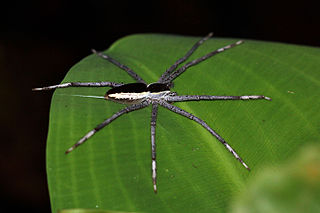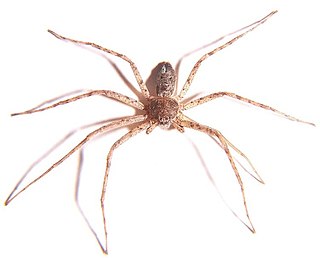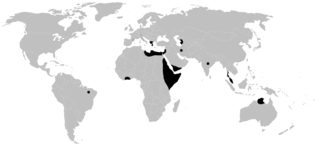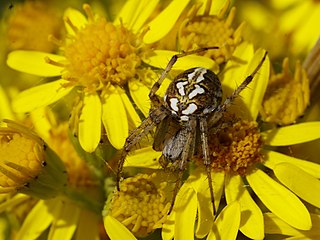
Huntsman spiders, members of the family Sparassidae, are known by this name because of their speed and mode of hunting. They are also called giant crab spiders because of their size and appearance. Larger species sometimes are referred to as wood spiders, because of their preference for woody places. In southern Africa the genus Palystes are known as rain spiders or lizard-eating spiders. Commonly they are confused with baboon spiders from the Mygalomorphae infraorder, which are not closely related.

Nursery web spiders (Pisauridae) is a family of araneomorph spiders first described by Eugène Simon in 1890. They resemble wolf spiders (Lycosidae) except for several key differences. Wolf spiders have two very prominent eyes in addition to the other six, while a nursery web spider's eyes are all about the same size. Additionally, female nursery web spiders carry their egg sacs with their jaws and pedipalps instead of attaching them to their spinnerets as wolf spiders do. When the eggs are about to hatch, a female spider builds a nursery "tent", places her egg sac inside, and stands guard outside, hence the family's common name. Like the wolf spiders, however, the nursery web spiders are roaming hunters that don't use webs for catching prey. They have a wide variety of prey, and larger species may prey upon vertebrates, particularly amphibians and fish.

Ground spiders comprise Gnaphosidae, the seventh largest spider family with nearly 2,000 described species in over 100 genera distributed worldwide. There are 105 species known to central Europe, and common genera include Gnaphosa, Drassodes, Micaria, Cesonia, Zelotes and many others. They are closely related to Clubionidae. At present, no ground spiders are known to be seriously venomous to humans.

Philodromidae, also known as philodromid crab spiders and running crab spiders, is a family of araneomorph spiders first described by Tord Tamerlan Teodor Thorell in 1870. It contains over 600 species in thirty genera. Most are dull colored- brown, gray, yellowish or mottled with a leaf-like cardiac mark on the anterior dorsal abdomen, and seldom reach above 10 millimetres (0.39 in) long. None of the species build webs, but they do use silk for draglines and egg sacs.

Cithaeronidae is a small family of araneomorph spiders first described by Simon in 1893 Female Cithaeron are about 5 to 7 millimetres long, males about 4 millimetres (0.16 in).

Stenochilidae is a family of southeast Asian araneomorph spiders that produce ecribellate silk. First described by Tamerlan Thorell in 1873, it now contains twelve described species in two genera.

Cheiracanthium, commonly called yellow sac spiders, is a genus of araneomorph spiders in the family Cheiracanthiidae, and was first described by Carl Ludwig Koch in 1839. They are usually pale in colour, and have an abdomen that can range from yellow to beige. Both sexes range in size from 5 to 10 millimetres. They are unique among common house spiders because their tarsi do not point either outward, like members of Tegenaria, or inward, like members of Araneus), making them easier to identify. The name is a reference to the backwardly directed process on the cymbium of the male palp. The species epithet is derived from the Greek Ancient Greek: χείρ, romanized: cheir, meaning "hand", and Acanthium, a genus of thorny-stemmed plants.

Neoscona, known as spotted orb-weavers and barn spiders, is a genus of orb-weaver spiders (Araneidae) first described by Eugène Simon in 1895 to separate these from other araneids in the now obsolete genus Epeira. The name Neoscona was derived from the Greek νέω, meaning "spin", and σχοῐνος, meaning "reed" They have a mostly pantropical distribution and one species, Neoscona adianta, has a palearctic distribution. As of April 2019 there are eight species that can be found in the United States and Canada:

Macrothele is a genus of mygalomorph spiders in the family Macrothelidae, and was first described by A. Ausserer in 1871. It is the only genus in the family Macrothelidae, and most species occur in Asia, from India to Japan, and Java, with four found in Africa, and two in Europe. The name is derived from Ancient Greek μακρός ("makro-"), meaning "big", and θηλή ("thele"), referring to the spinnerets.

Tibellus is a genus of slender crab spiders described by Simon in 1875, belonging to the order Araneae, family Philodromidae. Species of this genus are present in Eurasia, Africa, Americas and Australia.
Simalio is a genus of sac spiders first described by Eugène Simon in 1897.
Trachelas oreophilus is a species of spiders of the genus Trachelas. It is native to India and Sri Lanka.
Sphingius is a genus of araneomorph spiders in the family Liocranidae, containing 27 species restricted to South Asia and Southeast Asia.
Hermippus is a genus of ant eating spiders in the family Zodariidae, containing twelve species restricted to Asia and parts of Africa. Three new species were discovered in 2014.
Tibellus duttoni is a species of running crab spider in the family Philodromidae. It is found in the United States and Mexico.
Tibellus chamberlini is a species of running crab spider in the family Philodromidae. It is found in the United States and Canada.
Tibellus maritimus is a species of running crab spider in the family Philodromidae. It is found in North America, Europe, Caucasus, Russia, Central Asia, and China.









